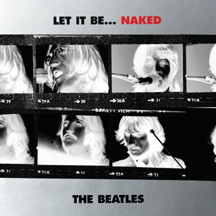LET IT BE . . . NAKED
Let it Be . . . Naked is a 2003 album by the English rock group the Beatles. It is a remixed and remastered version of their 1970 album Let it Be. The project was initiated by Paul McCartney, who had always felt that Phil Spector’s production did not represent the group’s stripped-down, back to their roots intentions for the album. Let it Be . . . Naked presents the songs “naked” – without Spector’s overdubs and without the incidental studio chatter featured between most cuts of the original album. Let it Be . . . Naked also replaces “Dig It” and “Maggie Mae” with “Don’t Let Me Down”, originally featured only as the B-side of the “Get Back” single. (More from Wikipedia)
Phil Spector’s work with the Beatles on their final album, Let it Be is more controversial, with many contending that it was more overproduction than production in that case. Ultimately, the album was re-released in 2003 without Spector's production and overdubs under the name Let it Be . . . Naked. Still, Phil Spector worked with John Lennon on several of his solo albums.
(October 2013)
* * *
Ultimately, a revised edition of Let it Be came out in 2003, due to the hostility by many to Phil Spector’s production efforts on the original album. It was called Let it Be . . . Naked and purportedly stripped the additions and corrections made by Spector to the original Beatles recordings. As with the Iggy Pop remix of the Stooges album Raw Power, however, successfully redoing an album that has been heard for many years by basically everyone having any interest at all in the music is easier said than done. Mark Deming notes in Allmusic: “In 1997, when Columbia made plans to issue a new edition of Raw Power, they brought in [Iggy] Pop to remix the original tapes and (at least in theory) give us the ‘real’ version we’d been denied all these years. Then the world heard Pop’s painfully harsh and distorted version of Raw Power, and suddenly [David] Bowie’s tamer but more dynamic mix didn’t sound so bad, after all.”
As to the Beatles’ attitudes toward the Let it Be . . . Naked reissue, Wikipedia notes: “[Paul] McCartney in particular was always dissatisfied with the ‘Wall of Sound’ production style of the Phil Spector mixes of three tracks, especially for his song ‘The Long and Winding Road’, which he believed was ruined by the process. George Harrison gave his approval for the Naked project before he died. McCartney’s attitude contrasted with [John] Lennon’s from over two decades earlier. In his December 1970 interview with Rolling Stone magazine, Lennon had defended Spector’s work, saying, ‘He was given the s--ttiest load of badly recorded s--t – and with a lousy feeling to it – ever. And he made something out of it. . . . When I heard it, I didn’t puke.’ Harrison and Ringo Starr also remained complimentary about Spector’s contribution, with Starr saying: ‘I like what Phil did. . . . There’s no point bringing him in if you’re not going to like the way he does it – because that’s [Wall of Sound] what he does.’”
So how did Let it Be . . . Naked go down 33 years after the original release of Let it Be? The same sort of muted comments that greeted the new version of Raw Power were in evidence here as well; Wikipedia lists some of them: Allmusic notes that Let it Be . . . Naked “is overall slightly stronger [than Let it Be] . . . a sleeker, slicker album”; Pitchfork notes that Let it Be . . . Naked is “not essential [. . .] though immaculately presented”; and Salon commented that Let it Be . . . Naked “stripped the original album of both John [Lennon]’s sense of humor and Phil Spector’s wacky, and at least slightly tongue-in-cheek, grandiosity.”
For myself, some tacky items stood out when I scanned the changes made in Let it Be . . . Naked that are listed in Wikipedia; they seem to go beyond adjusting whatever Phil Spector had added to the recordings. For “Dig a Pony”, Wikipedia states: “[The] error in second verse (the ‘because’ in [John] Lennon’s vocal track) [was] digitally corrected.” Similarly, in “Two of Us”, a “minor error in Lennon’s acoustic guitar performance [was] digitally corrected.” One of the live tracks, “I’ve Got a Feeling” is actually composed of “[a] composite edit of two takes from the rooftop concert”. After reading this, I have an image in my mind of a high school art student touching up an old master.
* * *
As to the tracks on Kum Back that did not show up on Let it Be, besides “Teddy Boy”, a performance for just under a minute of a blues song by Jimmy McCracklin called “The Walk” (also known as “Can He Walk”) also does not appear on Let it Be. The biggest surprise though is that one of the strongest songs made by the Beatles in their twilight years, “Don’t Let Me Down” – previously released in April 1969 as the b-side of the “Get Back” single – was also not included on Let it Be, though it was among the songs in the 2003 reissue, Let it Be . . . Naked. With the inclusion of “Don’t Let Me Down”, two short tracks, “Dig It” and “Maggie Mae” (not the same song as the Rod Stewart classic, “Maggie May”) were left off Let it Be . . . Naked. Together, these two songs run just 1:30; honestly, you’d think there would be enough room on the CD for them, too (neither appears on Kum Back either, though “Don’t Let Me Down” does).
(September 2017)















